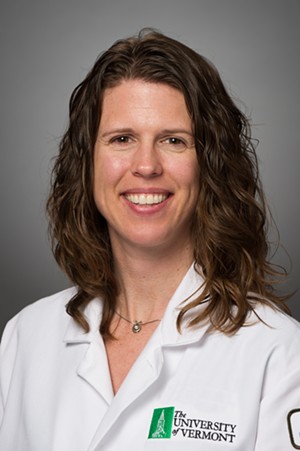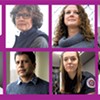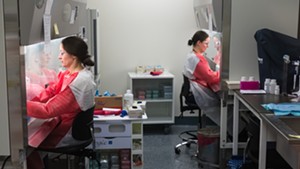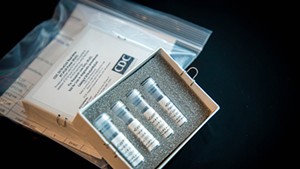
- Courtesy: University of Vermont Medical Center
- Dr. Erin Kurek
Editor's note: Seven Days is profiling some of the people defending Vermonters from COVID-19.
Should you become infected with COVID-19, there’s a decent chance you might end up in the care of Dr. Erin Kurek and her colleagues at the University of Vermont Medical Center in Burlington. Kurek, 42, has been a hospitalist there for eight years and was an attending hospitalist in Salt Lake City for three years before that.
If you’re unfamiliar with what a hospitalist does, that could be because it’s a relatively new term, coined about 25 years ago. Hospitalists are licensed internal medicine physicians who treat patients in a hospital rather than at outside offices or clinics.
“You can almost think of it as your primary care doctor, in the hospital,” Kurek explained.
Kurek’s floor at the hospital takes admissions from the emergency room and primary care doctors, as well as patients transferred from other hospitals who need a higher level of care. So far, the medical center has identified one positive case of COVID-19, more commonly known as the coronavirus. Kurek hasn’t treated that patient, though a colleague in her group has.
“Our group is working hard to disperse the work while keeping one person in charge of COVID rule-outs,” she said.
Numerous patients have come through exhibiting those worrisome, flu-like symptoms — dry cough, fever, shortness of breath.
Such patients under Kurek’s care have mostly come from the emergency room. She’s also had at least one patient who returned from Africa under observation for travel concerns.
“Because of the travel, there was a little extra hype on the floor from the nursing staff that it could be coronavirus,” Kurek said. “But she had no symptoms of coronavirus.”
When a patient who is suspected of infection comes in, they’re placed in one of the hospital’s negative-pressure rooms, which are designed to prevent the spread of infection. The rooms use lower air pressure than the environment around them. That allows air to flow in but traps it so that the air, and any contagions it might contain, can’t escape.
As an added layer of protection, Kurek and others whom she described as being “on the front lines” — such as emergency staff and certain nurses — are trained in the use of personal protective equipment, including respirators.
Kurek said that recommendations from hospital higher-ups for how to handle COVID-19 change daily, but that the plans generally mimic protocols for handling other infectious diseases.
“It’s the same kind of plan, so those themes are echoed,” she said. “The institution will try to limit the number of people that go in and out of rooms for folks that do have the coronavirus or are under high suspicion of coronavirus.”
When discussing the inevitability of treating patients infected with COVID-19, Kurek speaks with preternatural calm. That’s most likely because she’s seen pandemics up close before.
Kurek had just started working as an attending hospitalist in Salt Lake City during the 2009 outbreak of H1N1, a deadly flu that was particularly dangerous for young people. She was in her early thirties at the time and was also pregnant. “Younger people were faring worse, and you had young, pregnant women dying in the intensive care unit,” she recalled. “So I was much more cautious, but still took care of those patients.
“It’s what we do,” she continued. “It’s the coronavirus, but we take care of so many other infections and communicable diseases that it really is our daily life. We’re just upping the ante in how we protect ourselves.”
If anything, Kurek’s concerns are more outside the hospital than in it. She worries “if schools are going to be quarantined, or if I have to be quarantined. Just the logistics,” she said.
“But I’m not as worried for my health, or even my children’s health,” she continued, adding that data suggests older people, and those with existing health problems, are more likely to develop severe, potentially fatal symptoms.
Those are the same people, she noted, who are most vulnerable to the flu.
“We’ve had a really bad flu year,” she said. “I’ve had three patients in the last month that died from the flu.”
Seen from that perspective, Kurek’s even-keeled attitude toward COVID-19 starts to make more sense.
“As my husband says, for me, my reality is the hospital, so I’m always seeing the worst-case scenario,” she said. “So maybe that skews my perception.”
Still, for Kurek, there’s almost no place she’d rather be than the hospital, even amid a pandemic.
“I like taking care of sick folks,” she said. “I like the whole aspect of taking care of multiple different problems, from a patient with kidney failure to a stroke to a new cancer or a respiratory infection. It’s always changing and always keeping me on my game.”
Correction March 14, 2020: This story has been corrected to reflect that Dr. Erin Kurek was an attending hospitalist in Salt Lake City.


















Comments
Comments are closed.
From 2014-2020, Seven Days allowed readers to comment on all stories posted on our website. While we've appreciated the suggestions and insights, right now Seven Days is prioritizing our core mission — producing high-quality, responsible local journalism — over moderating online debates between readers.
To criticize, correct or praise our reporting, please send us a letter to the editor or send us a tip. We’ll check it out and report the results.
Online comments may return when we have better tech tools for managing them. Thanks for reading.